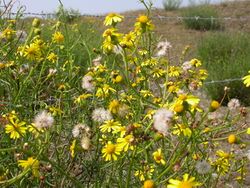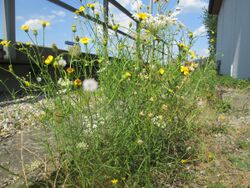Biology:Senecio inaequidens
| Narrow-leaved ragwort | |
|---|---|

| |
| Scientific classification | |
| Kingdom: | Plantae |
| Clade: | Tracheophytes |
| Clade: | Angiosperms |
| Clade: | Eudicots |
| Clade: | Asterids |
| Order: | Asterales |
| Family: | Asteraceae |
| Genus: | Senecio |
| Species: | S. inaequidens
|
| Binomial name | |
| Senecio inaequidens DC. (1838 )
| |
| Synonyms | |
|
Senecio madagascarensis, Senecio harveianus | |
Senecio inaequidens, known as narrow-leaved ragwort[4] and South African ragwort,[5] is a species of flowering plant in the daisy family Asteraceae.
Description
Senecio inaequidens is a perennial chamaephyte up to 1 m in height, often much ramified, with each stem ending in one or a few capitula yellow in colour, forming a loose floral display. A single plant produces 26 to 500 capitula each year, with approximately 90 florets, 74% of them developing a viable achene.[6] The leaves are linear, entire or almost so and without petioles.
S. inaequidens exists as a diploid genotype and a tetraploid cytotype. Initially the diploid S. madagascarensis and S. harveianus were assumed to be different species; however molecular analysis showed that they only differ in cytotype.[7]
Distribution
It is native to Southern Africa, including Lesotho, South Africa , Eswatini, Namibia, Mozambique and Botswana.[8]
Habitat
In its native habitat S. inaequidens occurs at elevations from sea level to 2,850 m in a wide range of naturally or anthropogenically disturbed habitats such as river banks, rocky slopes, heavily grazed or recently burned grasslands, and road verges.[9] The tetraploid cytotype was only found in the uKhalhamba and Maloti mountain ranges, and this is the cytotype of S. inaequidens which was inadvertently exported to Europe.
Invasive spread
The plant is a widespread neophyte in Europe and an invasive species in Central Europe.[10] It was introduced through wool imports from Southern Africa. In Europe the ports of entry were Bremen, Calais, Mazamet, and Verviers.[11]
S. inaequidens commonly exists in ruderal habitats such as railroads, roads and motorways, vacant or disused land.[12][13] Plants can be seen on disused land as pioneer species but so far often disappear in an ecological succession. In Central Europe where it first spread, the plant so far seems to use previously unused ecological niches. There does not seem a clear advantage over native vegetation, except in higher altitude. In the European Alps ecologists and farmers are worried that it has the advantage of invading grazing fields on the alm pastures.[14] The furthest north it was found was Norway .[15] S. inaequidens is also present in Korea and Taiwan.[16]
In South America and Australia the diploid variant S. madagascariensis is highly invasive.[17]
Properties
Senecio inaequidens contains pyrrolizidine alkaloids having hepatotoxic properties that are poisonous to mammals.[18]
References
- ↑ "Senecio Inaequidens". CAB International. 24 September 2019. https://www.cabi.org/isc/datasheet/49557.
- ↑ "Plant name details". International Plant Names Index (IPNI). Royal Botanic Gardens, Kew. https://www.ipni.org/n/245637-1.
- ↑ "Senecio inaequidens DC. record n° 98173". African Plants Database. South African National Biodiversity Institute, the Conservatoire et Jardin botaniques de la Ville de Genève and Tela Botanica. http://www.ville-ge.ch/cjb/bd/africa/details.php?langue=an&id=98173.
- ↑ (xls) BSBI List 2007, Botanical Society of Britain and Ireland, https://bsbi.org/download/3542/, retrieved 2014-10-17
- ↑ "Senecio inaequidens". Natural Resources Conservation Service PLANTS Database. USDA. https://plants.usda.gov/core/profile?symbol=SEIN10. Retrieved 9 November 2015.
- ↑ Vanparys, Valérie; Cawoy, Valérie; Mahaux, Olivia; Jacquemart, Anne-Laure (25 March 2011). "Comparative study of the reproductive ecology of two co-occurring related plant species: the invasive Senecio inaequidens and the native Jacobaea vulgaris". Plant Ecology and Evolution 144 (1): 3–11. doi:10.5091/plecevo.2011.434.
- ↑ Scott, L. J.; Congdon, B. C.; Playford, J. (1998). "Molecular evidence that fireweed (Senecio madagascariensis, Asteraceae) is of South African origin". Plant Systematics and Evolution 213 (3–4): 251–257. doi:10.1007/BF00985204.
- ↑ {{citation | mode = cs1 | title = Senecio inaequidens | work = Germplasm Resources Information Network (GRIN) | url = | publisher = [[Organization:Agricultural Research ServAgricultural Research Service (ARS), United States Department of Agriculture (USDA) | access-date = 2020-04-23 }}
- ↑ Lachmuth, Susanne; Durka, Walter; Schurr, Frank M. (October 2011). "Differentiation of reproductive and competitive ability in the invaded range of Senecio inaequidens: the role of genetic Allee effects, adaptive and nonadaptive evolution". New Phytologist 192 (2): 529–541. doi:10.1111/j.1469-8137.2011.03808.x. PMID 21736567.
- ↑ "Senecio inaequidens (South African ragwort)" (in en). https://www.cabi.org/isc/datasheet/49557#F4A6E092-9C11-43AD-A2E5-4ECEBF33260F.
- ↑ LACHMUTH, SUSANNE; DURKA, WALTER; SCHURR, FRANK M. (September 2010). "The making of a rapid plant invader: genetic diversity and differentiation in the native and invaded range of Senecio inaequidens". Molecular Ecology 19 (18): 3952–3967. doi:10.1111/j.1365-294X.2010.04797.x. PMID 20854275.
- ↑ Lachmuth, Susanne; Durka, Walter; Schurr, Frank M. (October 2011). "Differentiation of reproductive and competitive ability in the invaded range of Senecio inaequidens: the role of genetic Allee effects, adaptive and nonadaptive evolution". New Phytologist 192 (2): 529–541. doi:10.1111/j.1469-8137.2011.03808.x. PMID 21736567.
- ↑ Pietr Kocián (2016). "The first records of Senecio inaequidens along motorways in Poland and Slovakia". Acta Musei Silesiae, Scientiae Naturales 65 (2): 129–133. doi:10.1515/cszma-2016-0016.
- ↑ Vacchiano, G.; Barni, E.; Lonati, M.; Masante, D.; Curtaz, A.; Tutino, S.; Siniscalco, C. (27 November 2013). "Monitoring and modeling the invasion of the fast spreading alien S. inaequidens DC. in an alpine region". Plant Biosystems 147 (4): 1139–1147. doi:10.1080/11263504.2013.861535.
- ↑ "Boersvineblom funnet på Sjursøya i Oslo" (in Norwegian). County Governor's Office in Oslo and Akershus. 19 October 2010. http://www.fylkesmannen.no/hoved.aspx?m=4770&amid=3453667.
- ↑ Jang, Jin; Park, Su Hyun; Jung, Su Young; Chang, Kae Sun; Yang, Jong Cheol; Oh, Seung Hwan; Han, Yang Soon; Yun, Seok Min (2013). "Two Newly Naturalized Plants in Korea: Senecio inaequidens DC. and S. scandens Buch.-Ham. ex D.Don". Journal of Asia-Pacific Biodiversity 6 (4): 449–453. doi:10.7229/jkn.2013.6.4.00449.
- ↑ LÓPEZ, MARIANA G.; WULFF, ARTURO F.; POGGIO, LIDIA; XIFREDA, CECILIA C. (December 2008). "South African fireweed (Asteraceae) in Argentina: relevance of chromosome studies to its systematics". Botanical Journal of the Linnean Society 158 (4): 613–620. doi:10.1111/j.1095-8339.2008.00865.x.
- ↑ Dimande, A.F.P.; Botha, C.J.; Prozesky, L.; Bekker, L.; Rosemann, G.M.; Labuschagne, L.; Retief, E. (2007). "The toxicity of Senecio inaequidens DC.". Journal of the South African Veterinary Association 78 (3): 121–9. doi:10.4102/jsava.v78i3.302. PMID 18237033.
Wikidata ☰ Q939756 entry
 |


